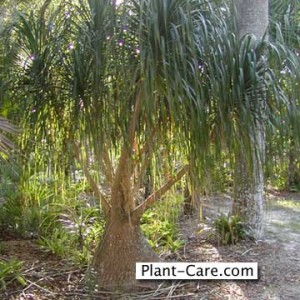Plant Illnesses
 Question from Karen:
Question from Karen:
I have three problems:
- I have a dwarf palm whose new leaves always have brown tips;
- I have a kumquat tree in a pot on my deck which has brown “stuff” dripping down the sides;
- I have a canary palm whose fronds have never “relaxed”. The fronds remain tightly together (if that makes sense).
Any help would be appreciated!
Answer from Pat:
Brown tips on palms are caused by wind damage or by salts in the ground. Many garden plants and house plants suffer from brown tips and in certain cases, such as ponytail palm (Nolina recurvata; Beaucarnia recurvata)—which despite its common name is not a palm—it’s virtually unavoidable.
Keep true palms healthy by feeding them during the warm months of the year with a fertilizer recommended for palms that includes iron as well as nitrogen, phosphorus, potassium and trace minerals. Water deeply and infrequently instead of often and shallowly, but palms in containers need more frequent irrigation. As soon as the soil almost dries out then apply water and irrigate plenty until you see water draining out the bottom of the pot and don’t allow the bottom of the pot to sit in the drainage water. This can lead to root rot.
Regarding your kumquat tree, this applies to all citrus trees: Brown sap oozing from the trunk and dripping down is a sign the tree is suffering from gummosis. Gummosis results from poor drainage or root rot. Make sure drainage is good. Treatment includes cutting away the diseased depression, or canker on the trunk from which sap is oozing, including 1/2 to one inch of healthy bark surrounding it, applying fungicide, and baring the scaffold roots so they can dry out. Sometimes the scars are cause by sprinklers hitting the trunk. Sometimes when the sprinkler problem is corrected and the cankers removed they dry up and heal themselves, but there is no complete cure and the trees usually die. Gummosis disease is caused by the soil-inhabiting fungus, Phytophthora. Next time only plant a kumquat that is grafted onto to a disease resistant root stock, such as Trifoliate orange or Troyer citrange. Both these are resistant to Phytophthora.
If dripping is from leaves, this is usually not brown but black and sooty and is caused by sucking insects, such as scale usually found on the backs of the leaves. Cures include (for house plants and pot plants): Dip a Q-tip in alcohol and remove all the insects. Wash off the foliage with mild dishwashing soap, such as Palmolive liquid and water. After that make sure the plant is appropriately fertilized and is in full sun. Very often porch or deck plants get sick because there is not enough sun.
Canary Island palm (Phoenix canariensis) is a huge, magestic tree when full grown, up to 35 feet wide and 50 or 60 feet tall. It is a feather palm not a fan palm. Occasionally people find these trees sprouting in gardens or drainage ditches in an area where many palms are grown and think they have a true Canary Island palm when it is actually a cross, a natural hybrid of two types of palm. Some of these palms have strange distortions. Also sometimes one purchases palm trees that have had all the fronds cut off except for a few central ones. Some landscape companies untie the fronds after planting. Others wait up to a month before untying the fronds. This is done to protect the meristem layer until the tree is established and growing again. (The meristem layer is the growing bud in the center of the top of the trunk.) Then after the plant is in the ground and after it has begun to grow again, they untie the fronds and the fronds loosen up and spread out. But when the new fronds first emerge from the meristem layer of a newly planted Canary Island palm they are always folded up like swords, as you describe. Fertilize and water the plant deeply and the fronds will begin to grow and blow around in the wind. Then they will not stick together any more. Canary Island palms need good drainage, full sun and deep watering.

